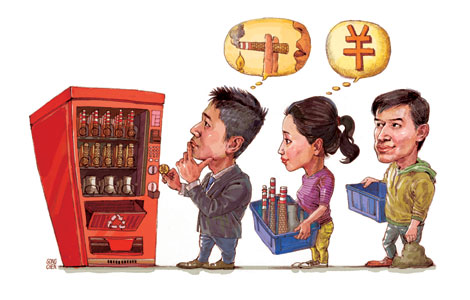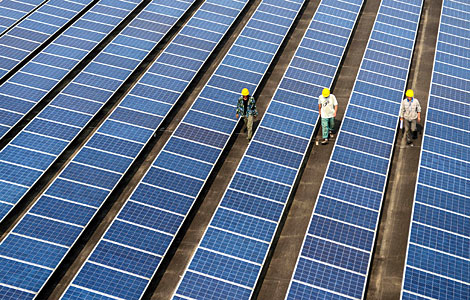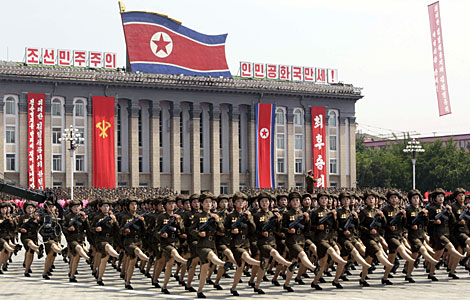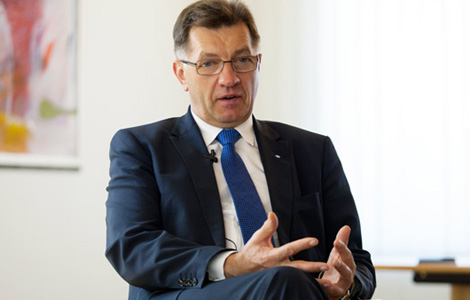'The bar is too high'
Updated: 2013-07-29 07:17
By Jiang Xueqing (China Daily)
|
||||||||
Foxconn Technology Group has nine companies in Shenzhen listed under the local government's carbon-emissions management program. This year, the group received 2.97 million metric tons of carbon credits. The figure will rise to 3.37 million tons in 2014 and 3.52 million tons in 2015, accounting for about 10 percent of the city's total carbon credits.
Foxconn's statistics show the group has not been granted a sufficient number of carbon credits this year, said Tsen Yao-shen, director of the Energy Efficiency Technology Committee at Foxconn.
"The government allocated carbon credits to companies based on their industry value added and CO2 emissions per unit of GDP. This will encourage high-profit enterprises but will hit low-profit, low value-added companies like Foxconn," said Tsen. "Every cent we make is hard earned. We wish the government had distributed the credits according to companies' industrial production growth."
In the first quarter of 2013, the weak global economy prompted a 15 percent fall in Foxconn's industry value added, compared with the same period last year. If the carbon-trading policy is implemented strictly and the pressure of emission reductions is too much for a company to bear, it will probably move part of its production chain to other cities, he said.
Despite the difficulties, Foxconn is still trying hard to meet the emissions reduction target set by the government. The group distributed its carbon credits to each department and ordered them to report their emissions levels every month. It also plans to build a trading mechanism within the group, so any department with a credit surplus, will be able to sell it to other departments.
In 2008, Foxconn founded the Energy Efficiency Technology Committee to take charge of the group's energy-saving and emissions-reduction work. By 2015, it will cut its energy consumption per unit of industrial output by 25 percent of the 2010 figure. Although the group's power consumption increased to 6.8 billion kilowatt hours in 2012 from 6.3 billion kWh in 2011, a rise of 7.9 percent, the power consumption growth rate remains far below the 16.1 percent growth in industrial output.
Last year, the group invested 254 million yuan ($41.4 million) in 532 energy-saving projects, saving 289 million kWh of electricity, equal to cutting carbon dioxide emissions by 203,000 tons.
Foxconn has also spent more than 23 million yuan to build a photovoltaic power station with an installed capacity of 2 megawatts at Longhua industrial park in Shenzhen. The station will generate 2.25 million kWh of electricity per annum, producing 2,232 fewer tons of carbon dioxide, 67.5 fewer tons of sulfur dioxide and 33.75 fewer tons of nitrogen oxide.
"We hope the government will introduce policies to encourage enterprises to increase investment in technological reform, while promoting corporate restructuring," said Tsen.
The Shenzhen municipal government has subsidies for energy-saving projects, but it requires each project to attract investment of at least 5 million yuan and save more than 1,000 tons of standard coal.
"The bar is too high for small projects and small companies, and the application procedure takes too long. Our factories in Shenzhen have just received subsidies of 4.2 million yuan on projects we filed an application for in 2011," said Tsen.
(China Daily USA 07/29/2013 page7)
Most Viewed
Editor's Picks

|

|

|

|

|

|
Today's Top News
Experts advise CEOs on how to make it in the US
Israeli-Palestinian peace talks to resume
Latest US-China talks should smooth the way
Audit targets local government debt
30 people killed in Italy coach accident
Brain drain may be world's worst
Industry cuts cloth to measure up to buyers' needs
Reckless projects undermine the prosperity hopes
US Weekly

|

|















